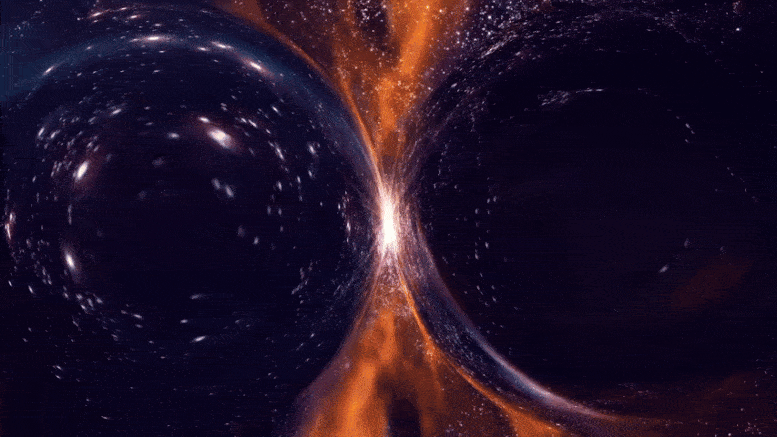Scientists working at the world’s largest atom smasher have caught a bizarre subatomic particle in the act of changing from matter to antimatter.
This discovery could help us understand how the universe was saved from total annihilation soon after it exploded into existence.
Using data from the second run of the Large Hadron Collider (LHC), researchers from Oxford University spotted the charm meson — a tiny particle that contains both a matter and an antimatter version of the quark, the fundamental building block of matter — transforming back and forth between the two states.
Each particle has an antiparticle counterpart with the same mass, lifetime, and atomic spin, but with the opposite charge. Some particles, such as the photon (light particles) are their own antiparticle, while others can exist as matter and antimatter at the same time, thanks to the strange quirks of a phenomenon called quantum superposition.
The charm mason falls into this last category. Quantum superposition – which arises from quantum mechanics, or the strange rules that govern the world of very small things – allows small particles to exist in many different states at once, essentially as a mixture of different particles, until said particles are observed. Rather than being just particles, they are also like small waves, where the size of these waves at any given point in space represents the probability of finding a particle at that point.
When the charm meson (formally called D0) and its antiparticle counterpart (anti-D0) exist in superposition, the waves of D0 and anti-D0 overlap in various ways to form two other matter particles, called D1 and D2, which are also in a state of superposition.
Even though D1 and D2 are made up of the same particle (D0) and antiparticle (anti-D0) ingredients as each other, they have slightly different mixtures of each, giving them different masses and lifetimes.
D1 and D2 can also be superimposed to produce a D0 or anti-D0, depending on how they are added on top of each other.
Since the mass of these particle waves determines their wavelength, and thus how they interfere with each other, it is the difference in mass between the heavier D1 and the lighter D2 that determines how quickly the charm meson switches between its matter (D0) and antimatter (Anti-D0).
To make a measurement with such accuracy, the researchers observed 30.6 million charm mesons just after they were made when two protons smashed together inside the LHC.
Charm mesons only travel a fraction of an inch before they decay into lighter particles, but the ultra-precise detectors inside the particle accelerator enabled the team to compare the charm mesons that traveled the shortest distance with those that went the farthest. The researchers then used that difference to calculate the difference in mass between the two possible states.
This is the second time a particle has been detected oscillating between matter and antimatter in this way, the first being a 2006 measurement of the Strange Beauty Meson.
But detecting this in the charm meson was much more difficult because the unstable particles usually decay before they can make the switch, according to the researchers.
Particles that can jump between matter and antimatter are important, because they lie at the core of one of science’s biggest mysteries: why the universe exists in the first place.
According to The Standard Model, the theory that describes the fundamental particles that make up the universe, matter and antimatter were created in equal quantities by the Big Bang. Yet the universe we live in is almost entirely made up of matter. And because matter and antimatter annihilate each other on contact, the universe should have annihilated itself the very moment, or soon after, it began. What then, was the cause of the imbalance?
Some hypotheses suggest that particles such as the charm meson could have saved the physical universe from annihilation—especially if they moved from antimatter to matter more than they went the other way.
With the upgraded Large Hadron Collider due to restart in September after being shut down for more than three years, and similar meson investigations set to be carried out by Japan’s Bell 2 experiment, finding more clues may not be far off.
Sources:

